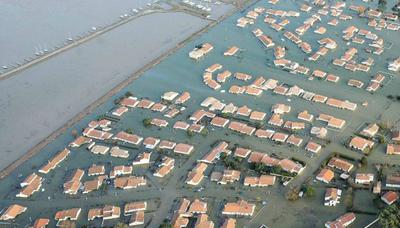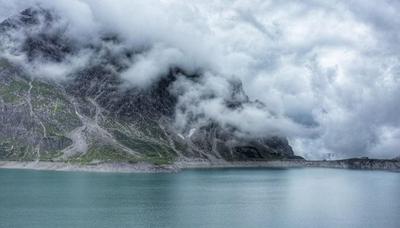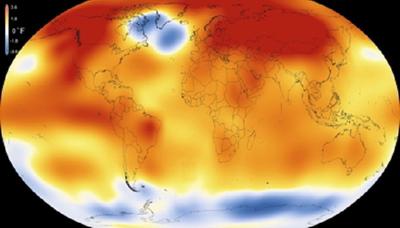The ocean at the heart of climate change
Introduction
INTRODUCTION : THE OCEAN AT THE HEART OF CLIMATE CHANGE
The ocean is rarely mentioned when it comes to climate change. However, it covers more than 70% of the surface of our planet and plays an essential role in regulating the climate. This huge mass of water also acts as a tank to store greenhouse gases that humans spew into the atmosphere and which are among the main reasons for our current climate change.
However, our precious oceans are fragile. Climate change is affecting this ecosystem. Water temperatures are getting warmer, making it more acidic, and sea levels are rising! These changes have an impact on marine biodiversity, but they also affect humans. In fact, people are dependent on the ocean, as it provides a range of resources. The rising sea levels are therefore a cause for concern when we know that 10% of the global population live near the coasts within 10 meters above sea level 1!
The ocean is essential to our life on Earth, but it is now threatened by climate change.
The climate and the ocean, an inseparable pair
The ocean is at the heart of the climate system. It regulates temperatures and precipitation on a regional scale and acts as the main carbon sink on Earth.
HOW DOES THE OCEAN REGULATE THE CLIMATE?
The ocean absorbs a part of the solar energy as heat. As solar radiation is at a maximum at the equator and minimum at the poles, water temperatures decrease as you move away from the equator. However, the many currents in the world’s oceans form what is called the “ocean conveyor belt”, which circulates large masses of water. On a globe scale, these currents carry warm water from the equatorial regions toward the poles and cold water from the polar regions to the equator. As some of the heat from the water is returned to the atmosphere, the ocean helps to regulate the temperature of the continents that surround it.
[Infographic 1: The major ocean currents: redistributing heat across the globe]
WHY DO WE CALL THE OCEAN A ‘CARBON SINK’?
A carbon sink is a natural or artificial tank that captures and stores carbon from the atmosphere. The oceans are the main carbon sinks on Earth, storing about 13 times more CO2 than the atmosphere, soil and continental plants combined.
This carbon storage is due to two major processes:
• biological: just like terrestrial plants, phytoplankton (all plant micro-organisms that live in water) absorbs CO2 and emits oxygen
• physicochemical: due to permanent exchanges that take place between the ocean surface and the atmosphere, some of the CO2 is absorbed and dissolved in water
[Infographic 2: Carbon capture mechanisms]
In addition to storing nearly 30% of the greenhouse gas emissions of human origin (of which CO2 is the main one 2), the oceans produce approximately half of the oxygen in the atmosphere. We should therefore give them a breath or two!
The ocean stores a portion of the carbon emitted by humans and, in turn, provides us with oxygen.
Since it plays a fundamental role in regulating the climate and helps to store much of the carbon released into the atmosphere, particularly due to human activities, it is important to ensure the ocean stays in good health. However, within the scope of the current climate change, this immense mass of water so essential for life is under threat.
The ocean affected by climate change
WHAT IS CLIMATE CHANGE EXACTLY?
The evolution of the Earth’s climates, defined as weather averages (temperatures, precipitation, sunshine, air humidity and wind, etc.) that affect a region for longer periods of time, is a phenomenon natural. For example, 15,000 years ago, the Sahara was not a desert. The climate there experienced much more rain in that part of the world, and the landscape was made up of lakes and prairies 3.
However, climate change today differs from the past climate variations given how fast it is changing, unprecedented in the history of the Earth, and also due to its human origin. Indeed, we humans are mainly responsible. Using fossil fuels (coal, oil and natural gas) for development, human societies have considerably raised the amount of greenhouse gases (GHG) in the atmosphere.
[Infographic 3: Origin of GHG emissions related to human activities]
This change in the composition of the atmosphere is the main reason for the increase in temperatures. In fact, greenhouse gases retain a portion of the Earth’s infra-red radiation within the atmosphere, causing it to heat up. Since the 19th Century, average temperatures have risen by one degree, and global warming is expected to result in an increase of 1.5°C between 2030 and 2052 4.
[Infographic 4: The greenhouse effect contributes to the warming of the atmosphere]
As climate change is caused by the rapid increase in GHG emissions of human origin, temperatures on Earth continue to increase.
WHAT ARE THE IMPACTS OF CLIMATE CHANGE ON THE OCEAN?
The ocean is an integral part of the climate system. If any element in this system is changed (in this case, rising temperatures), the ocean is also affected.
1: rising sea levels
As there are constant exchanges between air and water, the warming of the atmosphere also influences the ocean.
The increase in the ocean’s temperature causes, in turn, a rise in sea levels. During the 20th Century, the average increase in sea level is estimated at 10.7 cm 5.
This increase can be traced back to two phenomena:
• Ice melting: the rising temperatures are causing ice to melt (glaciers and polar caps). This adds to the amount of water in the ocean, increasing its volume and therefore raising sea levels.
• Thermal expansion: the hotter the water becomes, the more volume an equal amount of water occupies since the molecules under heat tend to vibrate and move away from each other.
[Infographic 5: Global warming is the origin of rising sea levels]
In the 20th Century, the average sea level rose by 10.7 cm.
2: ocean acidification
The increase in the amount of CO2 absorbed by the ocean, due to emissions of human origin, causes a change in its chemical composition and, in particular, a decrease in pH. This is why we refer to it as acidification.
[Infographic 6: The acidification of the ocean]
WHAT ARE THE MAIN CONSEQUENCES FOR OCEAN LIFE?
The warming of the ocean leads to a disruption of marine ecosystems. Some species may become extinct, while others show signs of proliferation. In addition, many species are forced to migrate because of the changing characteristics of the water they usually inhabit. Their entire local ecosystem is threatened!
LOBSTERS ON THE MOVE
A large number of lobsters live in the waters off the north-eastern coast of the United States. However, climate change causes an increase in the temperature of the ocean in this region, which disrupts the habit of these animals. As it has become difficult to live in waters that are too warm for them, lobsters migrate north at a speed of 70 kilometres every 10 years, and now greater numbers are appearing in the Gulf of St. Lawrence in Canada 6.
Other species are threatened by ocean acidification. In fact, if water becomes too acidic, some marine organisms can no longer properly make their calcareous shells or skeletons. As these species become more fragile, their entire ecosystem becomes disrupted, since they often play a vital role in the food chain.
CORAL REEFS UNDER THREAT
Coral reefs are complex ecosystems, made up of calcareous skeletons from marine organisms. They are extremely rich in biodiversity, since they are home to about a third of all marine species known to date. However, they are also a fragile environment, threatened by ocean acidification. In fact, as the water becomes more acidic, the organisms that make up the reef can no longer build their calcareous skeleton, which decreases the size of the reef. Coral reefs are also threatened by an increase in ocean temperatures. As the water becomes too warm, the corals lose their colour and eventually die. Worldwide, 19 percent of reefs have already been destroyed, and 15 percent are seriously damaged 7.
Global warming and acidification of the ocean are threatening marine biodiversity.
WHAT ARE THE MAIN CONSEQUENCES FOR HUMANS?
1: increase in risks in coastal areas
The rise in sea levels increases risks in coastal areas:
• Risk of erosion: the more ocean encroaches land, the more likely it is that sand is removed (beach shorelines) or rocks become unstable, increasing the risk of collapse (rocky shorelines). This phenomenon of erosion is causing a decrease in coastlines in many parts of the world.
• Risk of flooding: if the level of the oceans increases, areas at low altitudes will be flooded more regularly.
[Infographic 8: The risk of erosion and flooding]
Certain areas are particularly affected by this risk. These areas are strongly exposed to rising waters due to their natural characteristics (located at sea level or below), and to the many assets exposed (population, large economic activities or elements with an important heritage...). The risk is increased even more when people have few possibilities to adapt, for instance on small islands where there are limited opportunities to retreat to higher altitudes inland. This is the case on Kiribati, an island state in the Pacific which is seriously threatened by rising sea levels. Its government has begun preparing the migration of certain residents 8.
THE NETHERLANDS SUBMERGED?
The Netherlands are aptly named! In fact, a fourth of the country, home to 9 million people, lies under the sea level. Since the Middle Ages, the country has adapted to this situation by building protective barriers, such as dikes. However, with rising sea levels, increasing risk of flooding, these barriers may no longer be enough. The Netherlands, therefore, have invested millions of euros to reinforce their levies but also to invent new ways to protect themselves. Developing floating houses, for example, is a sign of the willingness to learn to live with the ocean rather than constantly being in opposition to it 9.
2: changes in local climates
As the ocean regulates the climate, any change to the ocean also has an impact on the climate. The increase in water temperatures disrupts major ocean currents, which changes local climates.
SUDDEN COLD IN EUROPE?
Even if the trend is towards a warming of the planet, then climate change can still have an opposite effect, particularly since it disrupts the major ocean currents that, in part, govern the temperatures on the surface of the globe, such as the Gulf Stream. This warm current, which crosses the Atlantic, is the reason behind the mild climate found in Western Europe. However, climate change is causing this current to slow down, which may ultimately cool down the climate in Europe 10.
3: disruption of human activity
Changes in marine biodiversity caused by the warming and acidification of the ocean also affect humans. In fact, this disrupts fishing activities, which is the initial supply of food for inhabitants of certain regions. However, it may also affect the tourism sector, by impacting activities like scuba diving, or even the pharmaceutical industry, since some marine species are used in the manufacture of drugs.
Conclusion
The ocean and climate act as an inseparable couple. As such, current climate change destabilises the balance in the oceanic environment. Water temperatures and sea level are on the rise. This has direct consequences on marine biodiversity but also on humans who use the resources from the ocean and who are largely settled in coastal regions.
WHAT ARE THE SOLUTIONS TO LIMIT CLIMATE CHANGE THAT IS CURRENTLY THREATENING THE OCEAN?
No one person can directly influence the climate. On the other hand, companies can work to reduce greenhouse gas emissions, and thus contribute to limit the warming of the atmosphere, by changing their production and consumption behaviour. This requires political decisions (for example, encouraging the development of public transport or renewable energy) but also a commitment from companies to operate with more environmentally friendly practices. However, everyone can also reduce their contribution to climate change with small, simple acts.
[Infographic 9: Actions to limit your impact on climate change]
Bibliography
1. Nations Unies, « The Ocean Conference », New-York, 2017.
2. Bopp L., Bowler C., Guidi L., Karsenti E. et De Vargas C., « L’océan, pompe à carbone », Océan et climat, Fiches scientifiques, 2016. www.ocean-climate.org.
3. Kröpelin. S., Verschuren D., Lézine A.-M., Eggermont H., Cocquyt C., Francus P., Cazet J.-P. et al., « Climate-Driven Ecosystem Succession in the Sahara: The Past 6000 Years », Science 320, no 5877, 2008. https://doi.org/10.1126/science.1154913.
4. GIEC, « Global Warming of 1.5 °C. Summary for Policymakers. », 2018, report.ipcc.ch/sr15/pdf/sr15_spm_final.pdf.
5. Cazenave A. et Llovel W., « Contemporary Sea Level Rise », Annual Review of Marine Science 2, no 1, 2009, https://doi.org/10.1146/annurev-marine-120308-081105.
6. Princeton University, « Movement of Marine Life Follows Speed and Direction of Climate Change », ScienceDaily, 2018, https://www.sciencedaily.com/releases/2013/09/130912143629.htm.
7. Allemand D., « Les coraux et le changement climatique », Océan et climat, Fiches scientifiques, 2016. www.ocean-climate.org.
8. Longépée E., « Les atolls, des territoires menacés par le changement climatique global ? L’exemple de Kiribati (Pacifique Sud) », Géoconfluences, 2015. http://geoconfluences.ens-lyon.fr/informations-scientifiques/dossiers-thematiques/oceans-et-mondialisation/corpus-documentaire/Kiribati.
9. Gueben-Venière S., « De l’équipement à la gestion du littoral, ou comment vivre avec les aléas météo-marins aux Pays-Bas ? », Géoconfluences, 2015. http://geoconfluences.ens-lyon.fr/informations-scientifiques/dossiers-thematiques/risques-et-societes/articles-scientifiques/littoral-pays-bas.
10. Caesar L., Rahmstorf S., Robinson A., Feulner G. et Saba V., « Observed Fingerprint of a Weakening Atlantic Ocean Overturning Circulation », Nature 556, no 7700, 2018, https://doi.org/10.1038/s41586-018-0006-5.





